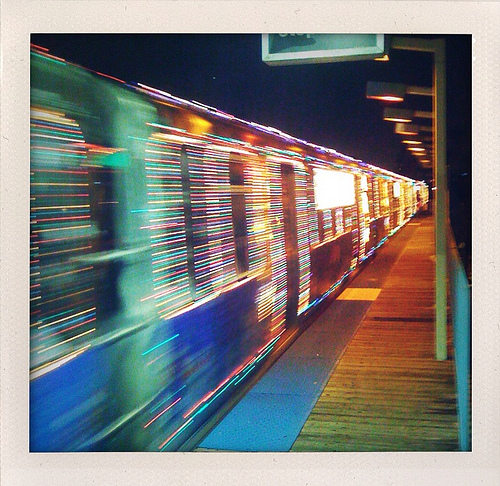Travel Times Scenario Outcome
by Flickr user Señor Codo
Travel times can be an effective way to judge the efficiency of the Transportation system. Time spent traveling is generally viewed as unproductive, so reducing travel times by lowering congestion, speeding transit service, and otherwise improving the Transportation system can have positive benefits in a number of areas. This outcome is closely related to the "congestion" and "jobs-housing access" outcomes.
Travel times in this analysis are calculated for both autos and for transit. The numbers used for this analysis include travel times for all trips; work trips usually have longer travel times than non-work trips (shopping, social, etc) because they usually cover longer distances. Currently, average auto travel times are 21.6 minutes and average transit travel times are 33.7 minutes. Both of these are expected to increase according to current trends, with auto travel times increasing to 22.7 minutes and transit travel times to 34.4 minutes.
Auto travel times
The impacts of each scenario on automobile travel times are described below, estimating travel times compared to the current trend (with a decrease considered to be an improvement). The base figure is 22.7 minutes.
Change from current trend |
|
|
Reinvest |
Improves |
|
Preserve |
Worsens slightly |
|
Innovate |
Mixed results |
Change in travel times |
|
|
Reinvest |
-14% (3 minutes less) |
|
Preserve |
+4% (1 minute more) |
|
Innovate |
+12% (3 minutes more) for some users; |
What strategies in this scenario caused this change? |
|
|
Reinvest |
Substantial increases in arterial and expressway capacity reduced travel times. Higher densities of development, which reduced distances between destinations, also contributed. |
|
Preserve |
Most Transportation strategies in this scenario prioritized other travel modes over autos, with limited change to auto travel times. |
|
Innovate |
Travel conditions were improved using technology and pricing transportation strategies, but this, combined with a low-density land use pattern, led to trips that covered long distances, therefore taking more time. Also, congestion pricing was applied on the region's expressways; this led to better travel times for people who were willing to pay the additional toll, but worse travel times for others. |
Transit travel times
The impacts of each scenario on transit travel times are described below, estimating travel times compared to the current trend (with a decrease considered to be an improvement). The base figure is 34.4 minutes.
Change from current trend |
|
|
Reinvest |
Improves slightly |
|
Preserve |
Improves slightly |
|
Innovate |
Improves slightly |
Change in travel times |
|
|
Reinvest |
-9% (3 minutes less) |
|
Preserve |
-5% (1 minute less) |
|
Innovate |
-8% (2 minutes less) |
What strategies in this scenario caused this change? |
|
|
Reinvest |
Transit-specific capital improvements increased the speed of transit trips. The scenario also included a denser land use pattern which brought origins and destinations closer together. |
|
Preserve |
Operational transit improvements and other low-capital strategies were applied. These operational improvements, plus a moderately denser land use pattern, increased the use of transit, particular for shorter trips. |
|
Innovate |
Travel conditions were improved using technology and pricing transportation strategies, including transit signal priority bus service on arterials and other features of Arterial Rapid Transit (ART), which led to more efficient transit service. |
These estimates were calculated by using the CMAP travel demand model to estimate the impacts of the strategies in the reports linked above. Documentation of travel demand model features is available here.
